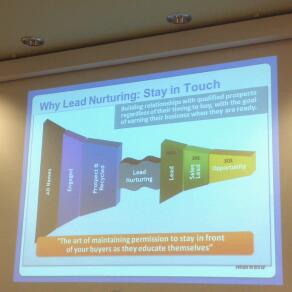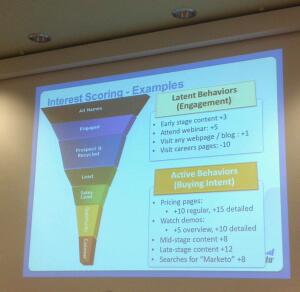You’ll find all the content of this blog, and lot more, at
Still focused on online marketing and communications, just the 2016 version of it!
You’ll find all the content of this blog, and lot more, at
Still focused on online marketing and communications, just the 2016 version of it!
Posted in Uncategorized | Leave a Comment »
There is a lot of interesting things going on in the fairly new field of behavioral economics. A while back I took a course through Coursera.org held by Dan Ariely. I truly recommend it to anyone that is even remotely interested in human behavior and motivations.
Watch a talk by him on TED here:
Are we in control of our own decisions
What makes us feel good about our work
Another interesting and rather mindblowing video is this one on the correlation between language spoken and likelihood to save money
Posted in Marketing | Leave a Comment »
I attended Marketo’s roadshow “Revenue Rockstar” earlier this week and wanted to share some key take-aways and thoughts with you guys.
First of all, marketing automation won’t be any better than the processes you apply it too. Secondly, it’s still about quality content.
The main improvements that Marketo clients notice is:
22% increase in nr of qualified leads
21% more leads convert to opportunities.
15% reduction in customer acquisition cost
7 % shorter sales cycle
“slow leads” converted at 3x the nr with nurturing – 20% vs. 6,67%
(although I’ m thinking similar figures would apply to any marketing automation software)

A pretty straight forward lead funnel, but nevertheless important.
Decide the relevance of your leads with a basic model, like “buying stage” vs “buying profile”
Next up you’ll have to do your due diligence on lead scoring. Here’s an example of Marketo’s interest scoring

When aligning sales and marketing set up an SLA (Service Level Agreement) to make sure sales-ready leads are handled accordingly and cold leads are nurtured properly. Marketo uses an “No Lead Left Behind” model with automated reminders & reports to management.
Marketo leads cycle
1. Reports & Analytics
2. Design studio etc to capture inquiry
3. New leads processing
4. Lead nurturing
5. Scoring & Insights
6. Life-cycle automation
Lead scoring needs to be setup on individual basis but should include:
Behavioral (download, web, email, search etc)
Demographic
Interesting moments
Decrease option
Analytics include:
Reports on campaigns (ROI, program cost, new leads etc)
Reports on individual deals
Find the marketing campaigns that drive conversions
Show the closed deals that marketing has worked on
+ ad hoc reports & dashboards
When you look at all of these functions you realize that setup may take a bit of time and effort, but that is what ensures your marketing automation really is automated, and more importantly, delivers value to your leads and customers.
Posted in Online tools | Tagged email marketing, inbound marketing, Marketing automation | Leave a Comment »
Do you use Instagram?
I don’t. That is, I didn’t until earlier today. But recently I’ve noticed that several of my “late majority” friends seem completely hooked. And we’re talking ppl who don’t really use Pinterest, Twitter and other fairly common social media communities.
That got me thinking… Why Instagram is such a hit? And how can I, as a marketer, use it?
Can I create a more professional looking site just by adding instagram pics?
Is it simply a lazy woman’s Photoshop?
Let us compare:

Poppy flower. Pic taken with my Motorola Atrix a few days ago. Not a bad picture, but it could do with some cropping and tweaking.

Same picture Instagram-style. Can’t tell you which filter I used, I simply picked the one that “felt right’
Pretty much a tie in which one is “prettiest”, don’t you think?
Let’s do another one!

My balcony plain and simple. No editing, not even closing the windows.

Instagram earlybird filter with extra sunlight.
The latter one is definitely the more artsy and professional looking one, wouldn’t you say?
Ok, one last one then.

No filter, no editing passionfruit flower (also located on my balcony)

Instagram version.
See, now I’m getting annoyed that ALL photos are square. But sure, Instagram might win over the non-edited one if looking for a “professional” photo. While I still feel you’re missing something of the of the original feeling.
I guess Instagram can stay in my phone for quick editing purposes, but I wouldn’t recommend anyone interested in pictures to use it exclusively. After all, how many 1977 pictures can you take before you feel like a broken record?!
Posted in Online tools | Tagged comparison, flowers, Instagram, lazy, Photos, professional, quick fix, shortcut | 3 Comments »
Do you consider yourself an average user of LinkedIn? Chances are you do! And yet, there are so many angles to the networking community left to investigate.
Down to basics
Name, title, picture, education, earlier work – its all very basic really. And yet, it took me 5+ years to fill in my profile to 100%. How many % complete is your profile?
What’s in a name
If you’re lucky you have a name people remember after hearing it once. If you’re like me, you have a fairly common name. But maybe you have a specialty? Some creative individuals add that right after their name (in the same field), ensuring it shows up everywhere your name does. A bonus is it supports the title section of your profile.
Your title, sir
Does your title and company say enough about your skills? Or are there other keywords that should be included? At first glance your name and title section is all another member can see, so make sure it reflects your areas of expertise (especially useful for groups and discussions)
Bells and whistles
Last but not least
Interact with people! Find ppl you know, but also ppl you’ve only met once or twice. However, unless you know them really well, make sure to change the standard message to something a bit more personal when you send a contact request!
Happy networking!
Posted in Online marketing | Tagged CV, job, LinkedIn, networking, online community | 1 Comment »
Just read a short article in HBJ on handling your email load. It’s an always aktuell topic, isn’t it.
This guy realized he could go through weeks of emails in 3 hrs after returning from vacation, while he normally spent 3 hrs per day doing the same.
His solution: email time; 30 minutes, 3 times per day. No more!
Could you do that?
I think we all would love to spend less time reading, answering, searching for and sending reminders on emails. But could you start doing that in an organization where everyone else answers emails every second of their workday and some event every second of every day? Would it take a decision by the whole organization for someone’s “email time” to not become a workplace problem?
Posted in Career | Tagged Email, expectations, organizations, workload | Leave a Comment »
I hardly use a computer anymore*. 99% of what I need to do I’ll use my iPad or even mobile for.
I admit, surfing the traditional web is sometimes a hassle on iPad (need I mention Flash), but most really interesting places have found a way to make it work without scaling to an old school mobile design (not Google, but them putting up a fight is understandable)
On the other hand you can imagine how much more effort the 1% is requiring nowadays – my computer is 5-6 years old at this point. Eventually I’m sure I’ll see the benefit of spending money on a new one.
My camera is basically replaced by my phone, and the result – I actually take pictures! It’s not really that I don’t like my camera (Sony Cybershot in hot pink). It’s actually awesome, but it’s over 4 years and the screen is a bit hard to read by now. If I didn’t love so much I’m sure I’d get a new one, but for the last year I’ve just replaced it more and more with my phone (Motorola Atrix 1). Since I use the camera so little I just recently realized that a big upside to it is that I can load my pictures straight on to my iPad, which it won’t let me do from my phone. Luckily sharing from my phone is idiot proof and covers every direction I’ve ever wanted to go in.
So what is the 1%?
Word-processing and saving documents as PDF
Watching tv-shows if I miss them (I’m traditional when it comes to watching TV)
Surfing certain sites that just don’t get it
Backing up my phone (honestly, I just don’t do it)
Creating presentations, PPT and Prezi (my pet peeve, should be so much more fun on iPad!)
What do you use your computer for? And better yet, which one should I go for when I just can’t take the 10 minute start-up process and the 1-minute-to-change-program anymore?
*At home that is. When it comes to work my laptop is glued to my fingertips!
Posted in Online tools | Tagged computer, laptop, mobile devices, progress, Technology | Leave a Comment »
Found this video on a blog and it just hit the spot! Much like the Swedish book “Boxen” by professor Micael Dahlén.
Posted in Uncategorized | Tagged Books, Inspiration, video | Leave a Comment »
On habit changing tablets
Early summer in the middle of Sweden. There’s six of us sitting on the front porch of the summer house. Two laptops with tonights Icehockey game is placed in front of most of them. Me, I’m watching the other nights gardening show on my iPad. I admit it, I never watch TV except for on TV before I got my iPad. It was too much hassle. The only reason I do it now is because it’s sooo easy. I have it next to my bed, I bring it to the summer house and watch it in the sun.
Later the same summer heat and humidity makes it impossible to be in our apartment. Having looked forward to finally watching a summer tv-show I simply placed the iPad on a table on the balcony and both me and my boyfriend could watch the show quite easily.
Granted it’s a bit silly to watch a 10″ when we have a 32″ and a 40″ in the apartment – but still!
Posted in Uncategorized | Tagged iPad, Life, summer, TV | Leave a Comment »